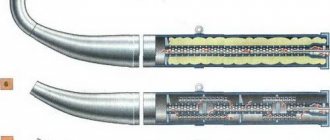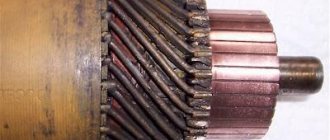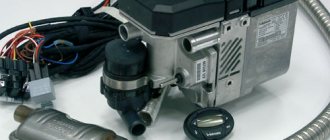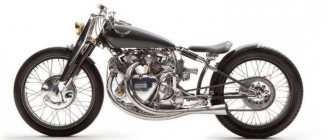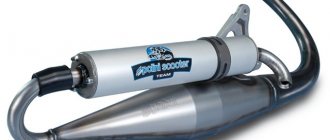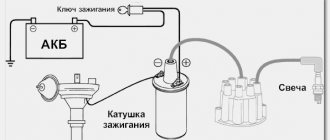The technologies that KTM is introducing into more and more models of road and off-road motorcycles are impressive! But how does it all work? The plant has prepared a series of visual videos.
Off-road traction control
What? Off-road traction control?! What nonsense?! - said avid endurists after the presentation in the summer of 2016 of the new next-generation KTM EXC-F, equipped with a traction control system on the ground. They then applauded after the first off-road test: European journalists showed the highest percentage of accident-free riding since the beginning of the organization of KTM press tests - not a single test pilot fell on motorcycles with OTC enabled! On motorcycles with OTC disabled, the number of crashes was the same as on normal tests. You can read what it is here. Here's how it works in practice:
Cornering ABS and MSC
Motorcycle Stability Control (MSC) was introduced by KTM in late 2013 and appeared on base 2014 models. .
Traction control - what is it? Not every experienced motorist can answer this question easily and quickly. Nevertheless, this system, firmly established under different names in cars of various brands, is considered one of the most effective means of active safety, with which manufacturers pin a number of hopes in the field of reducing accidents on the roads.
We will try to understand what modern traction control is and understand how effective it really is.
ASR / Traction Control - what is it?
So, let's figure out what traction control is? In simple terms, this is a system that includes a clutch that redistributes torque between the driving wheels of the car, an anti-lock braking system that selectively brakes the wheels, as well as a set of sensors with a control unit that coordinates the actions of these devices to dampen car skidding and wheel slip.
In fact, today traction control combines the capabilities of anti-skid and anti-slip systems, although it was originally created as an effective tool to combat slippage.
It is a well-known fact that the first automobile brand to commercially introduce traction control in cars was the American company Buick, introducing a system called MaxTrac in 1971.
The operation of the system was aimed at preventing slipping of the drive wheels, and the control unit, using sensors, detected the slipping and sent a signal to reduce engine speed by interrupting the ignition in one or more cylinders, that is, it “choked” the engine.
This scheme turned out to be very tenacious and is used today by almost all automakers. However, at that time the traction control system did not have the function of dynamic vehicle stabilization.
Japanese engineers from the Toyota concern played a significant role in the development of the Traction Control system (abbreviated as TRC). It was they who were one of the first to come up with the idea of using the principles embedded in the system to stabilize the car in the event of an emergency.
Video - Toyota company explains how traction control works:
What distinguishes TRC from Toyota is its comprehensive approach to system design, which includes angular velocity sensors in the car’s wheels, monitoring the rotation speed of each wheel, and the use of comprehensive traction reduction methods.
In the first versions of passenger cars, traction was also reduced by “strangling” the engine, and in modern versions of the system installed on (for example, the popular Toyota RAV-4), a selective reduction in the speed of rotation of one or another wheel is carried out using a standard viscous coupling, which receives signals from the central control unit of the system.
In this case, the viscous coupling does not reduce the torque on the slipping wheel, but proportionally increases the amount of torque on the wheel that has better traction. In this “forceful” way, the car returns to the required trajectory and there is no danger of developing a skid, but in the direction opposite to the slippery surface.
Application
The TCS traction control system is installed on cars of the Japanese brand “Honda”. Similar systems are installed on cars of other automakers, and the difference in trade names is explained by the fact that each automaker, independently of the others, developed a traction control system for its own needs.
The widespread use of this system has significantly increased the level of vehicle safety when driving due to continuous control of adhesion to the road surface and improved controllability when accelerating.
Advantages and disadvantages of modern Traction Control Systems
Modern traction control systems have a number of advantages and disadvantages. The first, of course, includes greater driving safety, because the system itself is capable of “recognizing” the risk of skidding and extinguishing its development.
On the other hand, such “assistance” relaxes the driver, which can lead to less caution when driving on slippery surfaces. In addition, do not forget about situations where wheel slip is not evil, but, on the contrary, can be a driver’s assistant.
By the way, this statement does not apply to fans of drifting and high-speed driving on race tracks, but to those drivers who often drive off-road or in deep snow. For example, traction control and anti-skid systems can play a cruel joke if you decide to overcome the “pull” of virgin snow.
By artificially limiting the speed, the system is able to turn off the car’s engine at the most crucial moment, and such a “gift” will end in the search for a tractor. To avoid such unpleasant situations, it is practically possible to disable traction control, for which a separate button is used on the center console of the car.
As a rule, it is marked with a corresponding designation (on the same Toyota crossovers it is “TRC off”). Using the key, you can deactivate the system in order to successfully overcome a difficult area.
Braking too early.
Try to be precise and consistent when braking, and aim to initiate braking at the correct point in the corner. Braking too early and then quickly accelerating to adjust the bike's lean is a classic mistake for almost any new rider. Later, as your speed increases, you will brake more harshly.
Using traction control in real operation
Despite the fact that many modern cars have a traction control option, not all drivers know how to use this system. Let's try to figure out how to use the traction control system using the example of a Toyota RAV-4.
In normal driving mode, the “default” so to speak, the TRC system on Toyota is constantly activated. Its intervention in control is completely invisible at first glance, but when one or more wheels of the car hit a slippery section of the road, the system comes into action, “directing” the car in the desired direction and preventing the development of a skid.
In practice, this can be noticed by the selective activation of the anti-lock brake system, which is accompanied by a characteristic crunch, as well as a decreasing response to the gas pedal. In addition, a corresponding indicator flashes on the dashboard, indicating that the system is activated.
Braking on slippery roads
A slippery road does not negate the principles of braking, but there are nuances here. On wet surfaces, grip is poor and braking force decreases. The shift of the center of mass from one wheel to the other is insignificant; both wheels have good contact with the road. This affects the braking distance, which can increase 4-5 times compared to a dry track. To stop properly, you need to use the rear brake more.
Algorithm
- Start braking from the rear wheel.
- Try to level the motorcycle.
- Stabilize the motorcycle with both brakes.
- Squeeze the brakes almost until the wheels lock.
In Toyota cars TRC OFF - what is this button and how to use it
In order to disable the stabilization system, as already mentioned, the driver will need to press the button labeled “TRC off” on the center console of your Toyota. This should be done as consciously as possible - only if wheel slip is really a necessary condition.
In addition to the above-mentioned off-road driving, it also makes sense to disable the traction control in cases where intensive acceleration of the car is necessary (for example, to overcome difficult sections on the road by “moving”).
It is worth mentioning separately the fact that in the Toyota crossover TRC is not completely disabled, that is, pressing the “TRC off” key only briefly deactivates the system. In addition, the system automatically turns on when the speed reaches 40 kilometers per hour, as indicated by the inscription “TRC on” on the dashboard.
Accordingly, if you need to turn it off again, the button will have to be pressed again. This precaution by the manufacturer is justified by safety standards, since today traction control is considered one of the most effective safety systems.
In fact, this statement is supported by statistics on road accidents in different countries, and many independent organizations are lobbying for the introduction of legislation requiring the use of TRC systems on all cars sold on the market, regardless of configuration.
Instant response
Returning to the 60 millisecond delay. Several design elements of the Zero SR/F electric bike make it extremely responsive. Low rotating mass leads to reduced inertia: the engine output shaft is connected directly to the rear wheel axle by a high-strength carbon belt. There are no delays or power losses on various multi-directional gears or chain drives. Moreover, in the Zero SR/F, the engine output shaft is located coaxially with the swingarm - so there is no change in transmission geometry when the suspension operates. So in the Zero SR/F electric bike, the engine and tire contact patch are connected to one of the fastest and most inertia-free transmissions of any motorcycle.
Zero SR/F
This allowed the Zero MSC integration team to unlock the full potential of MSC, which was not possible on ICE systems. The Bosch team has been predictably secretive (for intellectual property reasons) about its system's response time to traction loss events on ICE motorcycles. But according to independent experts - IEEE and the University of Tokyo, the delay between the wheel coming off and the electronic throttle position changing is about 200 milliseconds. Taking into account additional mechanical elements - transmission, chain, and so on - we should expect at least 300-400 milliseconds of total delay between the registration of a wheel slip and the action to restore the adhesion of the rubber to the road surface. Compare this figure to 60 milliseconds on SR/F!
Results
As you can see, traction control is a truly easy-to-use safety system that makes the driver's life easier. The possibility of forced shutdown allows you to avoid situations where the operation of the TRC could negatively affect vehicle control.
However, any electronics are only an assistant and in no way a guarantee of safety. Only the driver himself can make driving truly accident-free and competent.
Let's look at the so-called or when to change tires.
Find out how a car's traction control system works and what types there are. Diagrams and videos about the principle of operation of the system.
Contents of the article: For approximately 20 years, various security systems have been installed on cars, monitoring the safety of braking and acceleration of cars. Today, any modern car has such technologies.
Having gone through a long period of time and a difficult path, from simple systems up to entire complex systems that are combined into several traction control systems.
Emergency braking
Even experienced riders in a critical situation can forget about the rear brake - the hand automatically presses the handle of the front one. As a result, the motorcycle becomes uncontrollable and may fall. The fact is that 90% of the load during heavy braking is taken by the front wheel.
If you are used to braking with the front brake, try to use the rear brake as well. The main braking force will, as before, fall on the front wheel. However, using the rear brake will have a positive effect on the behavior of the motorcycle: its movement will be more stable and predictable.
Algorithm
- Smoothly apply the rear brake.
- Shift the motorcycle into a lower gear.
- Apply the front brake until the wheel is almost completely locked. However, feel the effort to prevent blocking.
- Downshift again.
What is traction control system?
The traction control system, or APS for short, is also called “traction control (PBS)”; in English you can also see two names for this technology - Dynamic Traction Control (DTC) and Traction control system (TCS), in German it is called Antriebsschlupfregelung (ASR) .
Traction control is a secondary safety feature that works with the ABS anti-lock braking system on cars, trucks and SUVs. This electro-hydraulic system of the car simplifies driving on wet roads (it prevents the wheels from losing traction with the road by constantly monitoring the slipping of the drive wheels of the car). Depending on the car manufacturer, traction control technology has the following names (types):
- ASR - installed on cars from companies such as Mercedes (as well as ETS), Volkswagen, Audi.
- ASC - installed on BMW cars.
- A-TRAC and TRC - on Toyota cars.
- DSA - available on Opel cars.
- DTC - installed on BMW vehicles.
- ETC - installed on Range Rover vehicles.
- STC - on Volvo cars.
- TCS - installed on Honda vehicles.
Without taking into account the large number of items, traction control systems are similar in design and operating principle, so let's look at the operating principle of the most common of them, namely ASR, installed in Mercedes, Volkswagen or Audi cars.
Links[edit]
- "Max Track". www.buick-riviera.com. Retrieved November 26, 2013.
- ^ a b "Ford Expedition 2003". www.ford-trucks.com. Retrieved September 14, 2012.
- "Expedition chassis". www.media.ford.com. Archived from the original on 2013-03-19. Retrieved November 8, 2012.
- "2012 Ford Ford Police Interceptor/Interceptor Utility - First Drive Review". www.caranddriver.com. Archived from the original on January 18, 2013. Retrieved September 14, 2012.
- "2013 Ford Expedition". www.Ford.com. Retrieved September 14, 2012.
- "2008 Porsche Cayenne". www.fourwheeler.com. Retrieved September 14, 2012.
- "Car #1 NWSMT Team Punished for Rule Violation". September 17, 2008. Retrieved November 7, 2022.
The ASR system and the nuances of its operation
ASR helps prevent loss of traction in a vehicle's wheels by using an electro-hydraulic system that controls the engine and brakes in adverse road conditions or if the driver uses excessive acceleration and the wheels begin to slip on the pavement. The ASR system helps the driver avoid making mistakes in adverse road conditions and helps the driver maintain control of the vehicle.
Professional drivers complain that ASR affects vehicle performance, but this standard equipment in high-performance vehicles helps beginners and drivers who often overestimate their ability to control the vehicle in adverse weather conditions, and restores driver control in unexpected circumstances.
ASR technology has been in most cars and motorcycles since about 1992. And it dates back to the early 1930s, when Porsche developed a limited-slip differential, which allows one wheel to spin slightly faster than the other to improve traction. The ASR system is closely related to ABS. The first users of ASR, which was already complemented by an ABS system, were BMW in 1979.
How the ASR system works
Common problems
A Toyota check engine light can come on for many reasons, ranging from a loose gas cap, a faulty ignition coil or spark plug, and even a blown head gasket. Let's take a look at the common problems that cause the check engine light on Toyota.
Fuel cap
Check engine light on Toyota Camry, Corolla, Sienna, 4Runner, Highlander, Matrix, Avalon, Rav4, etc. may come on if you do not tighten the gas cap . Find a safe place to stop. Make sure you install the gas cap.
If the gas cap is installed, tighten it.
Spark plug
Many Toyota owners don't realize that spark plugs are maintenance items.
Most Toyota vehicles require spark plug replacement between 90,000 and 120,000 miles.
If you don't replace your Toyota spark plugs within this time frame, they will eventually fail to cause the check engine light to come on. Additionally, you are more likely to get a misfire at the point where the engine starts to shake.
Idle control system
If you have an older Toyota with a cable drive, you may have problems with the idle air control system. In most cases , the idle air control valve becomes dirty or blocked by carbon buildup. This problem can be solved by cleaning the parts with carburetor cleaner. The throttle position sensor may also be faulty. Symptoms include a rough idle and hesitation when accelerating from idle. Code P0505
Vehicle speed sensor malfunction
Although Toyota is generally very reliable, it is well known for vehicle speed sensor failure.
This will trigger the check engine light in combination with the ABS/TC/Cruise lights. But a speedometer that doesn't work is a clear sign of a problem with the car's speed sensor.
The sensor is located on the output side of the transmission. Be sure to check the wiring and connector for damage. Typically you will receive a code P0500.
Crankshaft position sensor
If you are experiencing sporadic "won't start" situations, or your Toyota is shutting down for no apparent reason, you may have a bad crankshaft position sensor.
Before replacing the sensor itself, carefully inspect the wiring as it may suffer from heat damage. Code P0335.
Timing circuit
Check engine light on Toyota Camry, 4Runer, Highlander with V6 engines may be due to a stretched timing chain .
Although they are designed to last a lifetime, they may experience circuit overstress or tensioner failures. This can cause timing problems and associated engine error codes. Usually not a problem unless your Toyota has reached 200,000 miles and the timing chain has not been replaced.
Mass air flow sensor
If you experience a rough idle, lack of power, or hesitancy when accelerating, it's likely that your engine is running lean. Most Toyota engines have mass air flow sensors. This adds some complexity, and a possible vacuum leak causes the MAF to reset. Another common problem is an incorrect reading from a dirty MAF sensor. Do not use anything other than MAF cleaning fluid for cleaning. Code: P0171.
Oxygen sensor/catalytic converter
A check engine light caused by emissions control issues is something you're likely to encounter if you drive a high-mileage Toyota.
Although this will be signaled as low catalytic converter efficiency, it is possible that you have a faulty downstream oxygen sensor. Be sure to rule this out before replacing the much more expensive catalytic converter. Codes: P0420 to P0431.
Engine sucks
Many Toyotas made in the 2000s are susceptible to oil sludge caused by a blocked PCV valve.
This can cause a variety of problems ranging from high oil consumption, rough idling or check engine light, and even complete engine failure at highway speeds.
How the traction control system works and its nuances
The engine control unit controls the rotation of the wheels and after turning on the ignition, the vehicle begins to move. Computer monitors compare the acceleration and rotation speed of the drive wheels with the non-power wheels. The computer activates ASR when wheel rotation exceeds the slip threshold. The ASR system activates the brake valve differential to control the brake cylinder, and engine torque is applied to the braked wheel. Traction control technology moves from differential brake control to engine control to reduce engine power. In some systems, ASR retards ignition or reduces fuel flow to specific cylinders to reduce power at speeds above 50 mph. On the instrument panel you can see flashes of the warning lamp when the system is activated. This technology can also be disabled.
History[edit]
The predecessor to modern electronic traction control systems can be found in high-torque, high-performance rear-wheel drive vehicles in the form of a limited slip differential. A limited slip differential is a purely mechanical system that transfers a relatively small amount of power to the non-slip wheel while allowing some wheels to slip.
Buick introduced MaxTrac
, which used an early computer system to detect slippage
rear wheels and adjusting engine power to those wheels to provide maximum traction. [1] A Buick exclusive at the time, it was an option on all full-size models, including the Riviera, Estate Wagon, Electra 225, Centurion, and LeSabre.
Cadillac introduced traction control
(TMS) in 1979 on a redesigned Eldorado.
